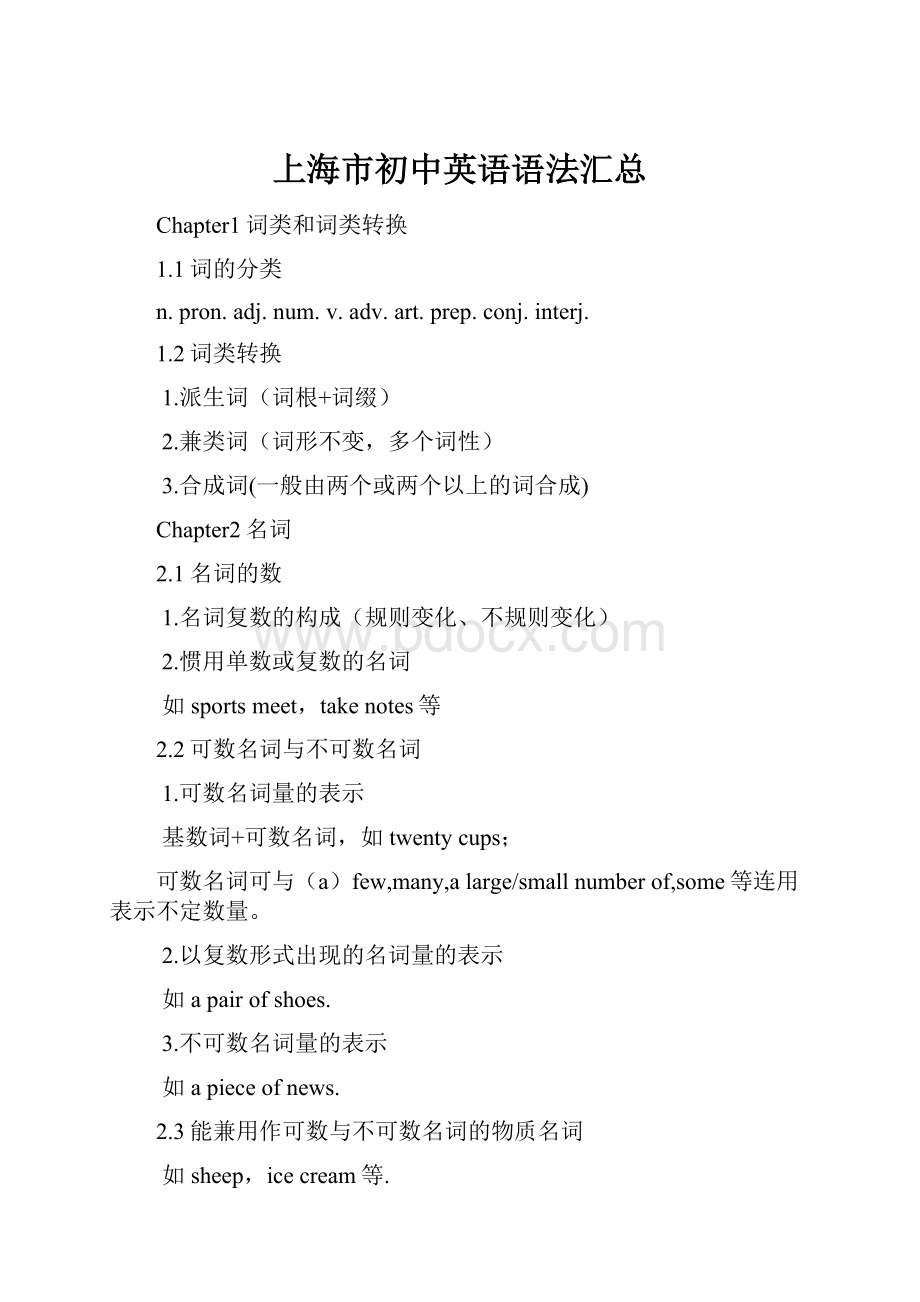上海市初中英语语法汇总.docx
《上海市初中英语语法汇总.docx》由会员分享,可在线阅读,更多相关《上海市初中英语语法汇总.docx(32页珍藏版)》请在冰豆网上搜索。

上海市初中英语语法汇总
Chapter1词类和词类转换
1.1词的分类
n.pron.adj.num.v.adv.art.prep.conj.interj.
1.2词类转换
1.派生词(词根+词缀)
2.兼类词(词形不变,多个词性)
3.合成词(一般由两个或两个以上的词合成)
Chapter2名词
2.1名词的数
1.名词复数的构成(规则变化、不规则变化)
2.惯用单数或复数的名词
如sportsmeet,takenotes等
2.2可数名词与不可数名词
1.可数名词量的表示
基数词+可数名词,如twentycups;
可数名词可与(a)few,many,alarge/smallnumberof,some等连用表示不定数量。
2.以复数形式出现的名词量的表示
如apairofshoes.
3.不可数名词量的表示
如apieceofnews.
2.3能兼用作可数与不可数名词的物质名词
如sheep,icecream等.
2.4同一名词用作可数与不可数名词时的意义差别
如change(零钱、变化).
2.5名词所有格
1.名词所有格的构成
2.-’s所有格的主要用法
3.of结构表示的所有关系
Of+名词,如theendoftheterm.
4.双重所有格
Of+名词所有格,如afriendofMr.White’s=oneofMr.White’sfriends.
Chapter3代词
3.1人称代词
1.人称代词主格与宾格形式
人称
第一人称
第三人称
第三人称
格
单数
复数
单复数
单数
复数
主格
I
我
we
我们
you
你,你们
he
他
she
她
it
它
they
他(它)们
宾格
me
us
you
him
her
it
them
2.人称代词的用法
3.it的用法
(1)it作代词代替上文中提到的无生命的事物或幼儿、动物。
(2)作“这、那”解,指心目中的人。
(3)作无人称动词的主语,表示时间、天气和距离。
(4)作先行词,引导非谓语动词如动词不定式。
3.2物主代词
1.物主代词形式
物主代词分为形容词性和名词性。
形容词性
my
我的
your
你的
his
他的
her
她的
its
它的
our
我们的
your
你们的
their
他们的
名词性
mine
yours
his
hers
its
ours
yours
theirs
2.物主代词的用法
3.3反身代词
1.反身代词形式
人称代词
I
you
he
she
it
we
you
they
自身代词
myself
我自己
yourself
你自己
himself
他自己
herself
她自己
itself
它自己
ourselves
我们自己
yourselves
你们自己
Themselves
他们自己
2.反身代词的用法
3.4指示代词
1.指示代词的形式
单数
this这
that那
复数
these些
those那些
2.指示代词的用法
3.5相互代词
eachother,oneanother
3.6疑问代词
1.who,what
2.who,which
3.what,which
4.whose
5.whom
3.7不定代词
1.one(s)
2.some,any
3.something,anything,nothing,everything
4.someone/-body;anyone/-body;noone/-body;everyone/-body
5.anyone/anybody,any(one)of
6.onone/nobody,none,nothing
7.everyone/everybody,every(one)of,each(one)of
8.one,everyone
9.both,all
10.either,any
11.neither,none
12.another,other(s)
13.(a)few,(a)little
14.many,much
15.most
3.8代词与其他词类的搭配
1.不定代词用作形容词与其他词类的搭配
(1)all/both+the或物主代词。
(2)some/any/many+other+名词。
2.代词用于表示时间
All,another,one,other,this/that,these/those
Chapter4冠词
4.1冠词的分类
a(an),the.
4.2不定冠词的用法
1.类别的表示
2.数量的表示
3.度量的表示
4.不定冠词惯用法
4.3定冠词的用法
1.特指
2.情景所指
3.前指
4.表示独一无二意义的名词
5.表示方位
6.形容词最高级
7.表示序列
8.表示自然现象
9.only/same+名词
10.定冠词惯用法
4.4不用冠词的情况
1.表示交通工具
2.表示一日三餐
3.表示季节
4.表示体育运动和乐器
5.个体名词表示抽象意义
6.表示学科
7.表示称呼
8.不用冠词的惯用语
4.5时间表示中冠词的使用
不用冠词
定冠词
节假日
NewYear’sDay元旦
NewYear’sEve除夕
ChristmasDay圣诞
Children’sDay儿童节
theSpringFestival春节
theDragonBoatFestival端午节
月份
January一月
April四月
日
Tuesday星期二
Friday星期五
年饭
19771977年
20002000年
theyear19771977年
theyear20002000年
一天各段时间
atnoon正午
atnight晚上
atmidnight半夜
onweekends在周末
inthemorning上午
intheafternoon下午
intheevening晚上
inthenight夜里
ontheweekend周末
mostofthetime大多数时间
atthemoment此刻
4.6专有名词前冠词的使用
不用冠词
定冠词
说明
人名
Alice艾丽丝
Mr.Lee李先生
ProfessorMartin马丁教授
theBrowns布朗一家
the+姓氏复数表示一家人
洲名
Africa非洲
SouthAmerica南美洲
国家
China中国
Britain英语
Australia澳大利亚
Switzerland瑞士
theNetherlands荷兰
theUnitedStatesofAmerica美利坚合众国
thePeople’spublicofChina中华人民共和国
定冠词用于国家全称
城市地区
Shanghai上海
London伦敦
NewYork纽约
theSouthPole南极
theNorthPole北极
路街
BeijingRoad北京路
25thStreet25号大街
场所
TianAnMenSquare天安门广场
NanpuBridge南浦大桥
BeihaiPark北海公园
theGreatWall长城
theSummerPalace颐和园
普通名词组成的专有名词前须加定冠词
语言
English英语
German德语
French法语
theEnglishlanguage英语
theGermanlanguage德语
theFrenchlanguage法语
报刊
ChinaDaily《中国日报》
theNewYorkTimes《纽约时报》
机构活动
theYoungPioneers少先队
theOlympicGames奥林匹克运动会
江河海洋
theYangtzeRiver长江
theYellowRiver黄河
theSouthChina南中国海
thePacific太平洋
山脉山峰
MountTai泰山
theHimalayas喜马拉雅山脉
山脉前用定冠词,但山峰名称前多不用定冠词
Chapter5数词
5.1数词的分类和构成
1.1-12
基数词
序数词
说明
1one
1stfirst
1.1-12为基数词中的基本数词。
2.序数词1-3为特殊变化。
3.序数词4-12在相应基数词词尾加-th构成。
注意:
fifth第五,ninth第九和twelfth第十二的特殊拼写。
2two
2ndsecond
3three
3rdthird
4four
4thfourth
5five
5thfifth
6six
6thsixth
7seven
7thseventh
8eight
8theighth
9nine
9thninth
10ten
10thtenth
11eleven
11theleventh
12twelve
12thtwelfth
2.13-19
基数词
序数词
说明
13thirteen
13ththirteenth
1.13-19基数词在数词3-9后加-teen构成。
其中13,15发生拼写变化。
2.序数词在基数词后加-th构成。
14fourteen
14thfourteenth
15fifteen
15thfifteenth
16sixteen
16thsixteenth
17seventeen
17thseventeenth
18eighteen
18theighteenth
19nineteen
19thnineteenth
3.20-99
基数词
序数词
说明
20twenty
20thtwentieth
1.20-90整十位数,在基数词2-9之后加后缀-ty构成。
其中20、30、40和50拼写发生变化。
2.20-90整十位数的序数词构成时,将相应基数词词尾-y变成i,加-eth。
3.十位数之间的数,由十位数加个位数构成,中间用连字符号。
构成序数词时,十位数用基数词表示,个位数用序数词表示。
21twenty-one
21sttwenty-first
29twenty-nine
29twenty-ninth
30thirty
30ththirtieth
40forty
40thfortieth
50fifty
50thfiftieth
60sixty
60thsixtieth
70seventy
70thseventieth
80eighty
80theightieth
90ninety
90thninetieth
93ninety-three
93rdninety-third
99ninety-nine
99thninety-ninth
4.100-1,000,000
基数词
序数词
说明
100onehundred
100th(one)hundredth
1.整百位数由1-9加hundred构成。
相应序数词在词尾加-th。
2.百位数含十位数和个位数时,百位数与十位数之间用and连接,也可以省略,但百位数加个位数时,and一般不省去。
构成序数词时,只将最后一个数变成序数词。
3.千位数1-9加thousand构成。
4.千位数带百、十、个位数可由千位数直接加百、十、个位数构成。
5.汉语中的“万”在英语中用“千”作单位。
6.百万以million为单位。
7.千至百万的序数词,将最后一个词变为序数词。
200twohundred
200thtwohundredth
202twohundredandtwo
202ndtwohundredandsecond
247twohundred(and)forty-seven
247thtwohundred(and)forty-seventh
1,000onethousand
1,000th(one)thousandth
2,000twothousand
2,000thtwothousandth
2,001twothousand(and)one
2,001sttwothousandandfirst
2,425twothousand,fourhundred(and)twenty-five
2,425thtwothousand,fourhundred(and)twenty-fifth
10,000tenthousand
10,000thtenthousandth
100,000onehundredthousand
100,000thonehundredthousandth
1,000,000onemillion
1,000,000th(one)millionth
5.2分数词
5.3half的用法
5.4不定数量的表示
5.5大约数的表示
5.6数词的表示
基数词
序数词
时刻
7:
00seveno’clock
7:
30halfpastseven;seventhirty
8:
15(a)quarterpasteight;eightfifteen
1:
45(a)quartertwo;oneforty-five
6:
50ten(minutes)toseven;sixfifty
6:
09nineminutespastsix;sixnine
9:
34twenty-sixminutestoten;ninethirty-four
月日
4月5日
April5(th);5(th)April
7月2日
July2(nd);2(nd)July
年份
1998nineteenninety-eight
the20thcentury
20世纪
1803eighteenothree;eighteenandthree
2004twothousandandfour
the1980s/1980’sthenineteeneighties
事物编号
LessonTwo第二课
theSecondLesson
PartOne第一部分
theFirstPart
UnitThree第三单元
theThirdUnit
page51第51页
Room308308室
Flight129129航班
Bus(No.)4646路公共汽车
WorldWar2第二次世界大战
theSecondWorldWar
电话号码
63214578sixthree,twoone,fourfive,seveneight
02-639877otwo,sixthree,nineeight,sevenseven
算式
2+3=5Twoand/plusthreeis/makesfive.
10-6=4Tenminussixis/leavesfour.
4*5=20Fourtimesfiveistwenty.
16/4=4Sixteendividedbyfouris/givesfour.
5.7年龄的表示
Chapter6形容词和副词
6.1用作表语的形容词
6.2用作定语的形容词
6.3形容词的主动意义和被动意义
6.4常用副词用法讨论
1.ago,before
2.just,justnow
3.late,later(on)
4.already,yet,still
5.ever
6.almost,nearly
7.so
8.too
9.very,verymuch
10.somewhere,anywhere
6.5-ly结尾的副词
6.6else
6.7疑问副词
1.how,when,where,why
2.how+形容词构成的疑问词
3.how+副词构成的疑问词
4.how与what的某些用法区别
6.8形容词和副词比较级和最高级
1.形容词和副词比较级和最高级的构成
(1)形容词和副词比较级和最高级的构成
-er,-est形式:
分类
例词
说明
原级
比较级
最高级
单音节
一般单音节单词
short
shorter
shortest
young
younger
youngest
poor
poorer
poorest
-e结尾
large
larger
largest
以-e结尾的形容词加-r或-est。
wide
wider
widest
重读闭音节,且词尾为单个辅音字母
big
bigger
biggest
词尾辅音字母双写后再加-er,-est。
hot
hotter
hotest
辅音字母+y结尾
dry
drier
driest
将词尾y改为i再加-er,-est。
双音节
以-y,-er,-ow结尾
easy
easier
easiest
多采用-er,-est形式。
clever
cleverer
cleverest
narrow
narrower
narrowest
more,most形式:
分类
例词
原级
比较级
最高级
一般双音节形容词
careful
morecareful
mostcareful
active
moreactive
mostactive
useful
moreuseful
mostuseful
三音节以及三音节以上的形容词
difficult
moredifficult
mostdifficult
interesting
moreinteresting
mostinteresting
-ed结尾的形容词
tired
moretired
mosttired
worried
moreworried
mostworried
(2)副词比较级和最高级的规则变化
构成方法
例词
原级
比较级
最高级
单音节副词采用-er,-est形式。
fast
faster
fastest
quick
quicker
quickest
hard
harder
hardest
soon
sooner
soonest
以-ly后缀词尾的副词采用more,most形式。
carefully
morecarefully
mostcarefully
warmly
morewarmly
mostwarmly
quietly
morequietly
mostquietly
(3)形容词和副词比较级和最高级的不规则变化
原级
比较级
最高级
说明
many
much
more
most
good
well
better
best
bad
badly
ill
worse
worst
Badly作“迫切,非常”解时,采用more,most形式。
如:
Teachersareneededmorebadlyinourcitythanintheirs.
little
less
least
far
farther
further
farthest
furthest
farther,further都可以表示距离、时间上的“更远、更往前”,但表示“进一步”只能用further。
例如:
Wewentfarther/furtherinto
thewoods.我们再向树林里面走去。
Weneedfurtherinformation.我们需要进一步的信息。
old
older
elder
oldest
eldest
1.older,oldest用于比较年龄的大小。
例如:
Heisolderthanme.他比我大。
2.elder,eldest用于表示家庭成员间长幼关系。
例如:
Sheismyeldersister.她是我姐姐。
Aliceistheeldestdaughterinthefamily.艾丽丝是家中的长女。
3.美国英语中older,oldest用于表示家庭成员间长幼关系。
例如:
Benismyolderbrother.本是我的哥哥。
Hankismyoldestson.汉克是我的长子。
2.形容词和副词比较级和最高级的常用结构
3.比较级程度的表示
4.比较中应注意的问题
Chapter7动词分类
7.1及物动词与不及物动词
1.某些容易混淆的及物动词与不及物动词
2.易被误用为及物动词的不及物动词
3.易被误用为不及物动词的机务动词
7.2连系动词
7.3短语动词与介词动词
1.短语动词
2.介词动词
7.4动词变形
1.加-s规则
pass
规则
例词
一般动词在词尾加-s。
take→takes
bring→brings
burn→burns
change→changes
以-s,-sh,-ch,-x结尾的词,在词尾加-es。
pass→passes
wash→washes
match→matches
fix→fixes
以-o结尾的动词加-es。
do→does
go→goes
以辅音字母+y结尾的动词,将y改为I,加-es。
study→studies
carry→carries
以原因字母+y结尾的动词,在词尾加-s。
play→plays
pay→pays
2.构成动词-ing形式的规则
规则
例词
一般动词在词尾加-ing。
ring→ringing
push→pushing
buy→buying
以辅音字母+e结尾的动词,去掉e加-ing。
live→